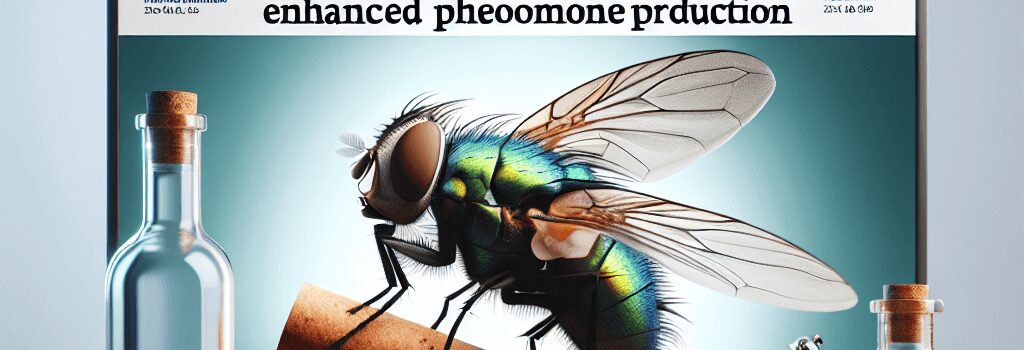Intoxicated by Innovation: How Alcohol Fuels Male Fruit Fly Mating Success Through Enhanced Pheromone Production

Fruit flies (Drosophila melanogaster) are not only models for genetic research, they also continue to offer intriguing insights into behavioral neuroscience. Recent research published in Science Advances reveals that male fruit flies ingest alcohol to boost pheromone production, thereby increasing their attractiveness to potential mates. This fascinating discovery underscores the complex interplay between environmental stimuli and intrinsic mating behaviors, serving as a prime example of how even simple organisms exhibit sophisticated adaptive strategies.
Alcohol as a Behavioral Modulator
The study conducted by researchers including Ian Keesey of the University of Nebraska, Lincoln, builds on decades of work on fruit fly behavior. In their experiments using a device known as the Flywalk, individual fruit flies were exposed to precise concentrations of ethanol and methanol. Advanced imaging techniques allowed scientists to monitor neural activity in real time as the male flies encountered these stimuli. The results showed that alcohol consumption, particularly methanol, directly increases the production of key sex pheromones, chemicals critical for courtship rituals.
Unlike human social behaviors where alcohol often impairs judgment, male fruit flies appear to have evolved a regulatory neural mechanism. The study identified three distinct neural circuits balancing attraction and aversion responses. This balance prevents overconsumption and intoxication, ensuring that the male flies achieve just the right level of inebriation to become enticing without risking adverse effects that could deter females.
The Underlying Neural Mechanisms
Delving deeper into the technical aspects, the research revealed that alcohol exposure modulates neural pathways responsible not only for pheromone production but also for reward and risk assessment. When a male fruit fly consumes alcohol, there is an upregulation in neural circuits associated with pheromone biosynthesis. Meanwhile, other circuits serve as a check, preventing the flies from reaching intoxication levels that would lead to disoriented or erratic behavior. This dual-pathway system is unusual, highlighting the evolutionary innovation that allows these insects to finely tune their physiological responses based on environmental cues.
Behavioral Consequences and Advanced Experimental Design
The experimental setup also shed light on a prior hypothesis concerning the relationship between social defeat and alcohol consumption. Previous studies, such as those led by Ulrike Heberlein, indicated that male fruit flies experiencing rejection would consume more alcohol—likely as a form of self-medication to activate reward centers. However, the latest findings posit an alternative explanation: rather than serving as a coping mechanism, increased alcohol intake is strategically leveraged to maximize subsequent mating success.
Researchers employed the Flywalk apparatus with high-precision odor delivery systems and synchronized video monitoring to observe the responses of 15 fruit flies placed in parallel glass tubes. This setup allowed for high-throughput behavioral assays that not only recorded movement but also monitored changes in pheromone levels using state-of-the-art fluorescent imaging techniques.
Cross-Disciplinary Insights and Future Implications
These discoveries provide a bridge between behavioral neuroscience and technological advancements in imaging and automation. The integration of automated behavioral assays with neural imaging serves as a new paradigm in studying the genetic and environmental influences on behavior. Expert opinions from neuroscientists suggest that understanding these fundamental mechanisms in a simple organism like the fruit fly could pave the way for insights into human neural circuitry, particularly in relation to addiction and the modulation of social behaviors.
Technical Analysis and Broader Impact
From a technical perspective, the identification of three balancing neural circuits is of particular interest. It illustrates how even relatively simple nervous systems in insects are capable of complex computations, including risk management and decision-making based on internal states and external inputs. These insights are bolstered by the use of high-resolution confocal microscopy and genetically encoded calcium indicators, which allow for precise mapping of neural activity in response to ethanol and methanol exposure.
Furthermore, this research has implications for the design of artificial neural networks (ANNs) where balancing opposing forces to avoid overfitting is a common challenge. The biological systems observed in the fruit fly could inspire new algorithms that mimic these natural balancing mechanisms, thereby enhancing the efficiency and adaptability of ANNs.
Conclusion and Future Research Directions
This study offers a compelling example of how natural selection tailors behavioral strategies in response to environmental factors. As male fruit flies optimize their alcohol consumption to enhance mating success by modulating pheromone production, they illustrate a remarkable evolutionary adaptation. Future research may further explore how these neural circuits interact at the molecular level, potentially uncovering targets relevant for managing alcohol-related behaviors in higher organisms, including humans.
Overall, the blend of advanced technical methodologies with behavioral observations in this study represents a significant leap forward in our understanding of neuromodulation and adaptive behavior in a model organism, with potential cross-disciplinary applications spanning neuroscience, computational biology, and artificial intelligence.